
USS Bass (SF-5/SS-164), a Barracuda-class submarine and one of the "V-boats", was the first ship of the United States Navy to be named for the bass.

USS Du Pont (DD–152) was a Wickes-class destroyer in the United States Navy during World War II, later reclassified as AG-80. She was the second ship named for Rear Admiral Samuel Francis Du Pont.
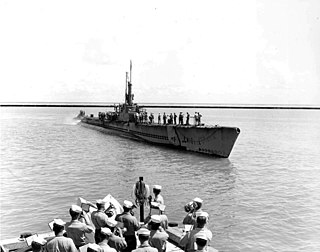
USS Cabrilla (SS/AGSS-288), a Balao-class submarine, was a ship of the United States Navy named for the cabrilla, an edible fish inhabiting the Mediterranean Sea and waters off the coast of California.

USS Bumper (SS-333), a Balao-class submarine, was a ship of the United States Navy named for the bumper, a small fish of the North and South Atlantic Ocean.
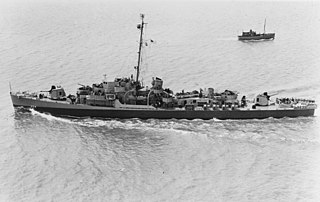
USS Rudderow (DE-224) was the lead ship of her class of destroyer escorts, in service with the United States Navy from 1944 to 1947. After spending decades in reserve, she was sold for scrap in 1970.

USS Dahlgren (DD-187/AG-91) was a Clemson-class destroyer which served in the United States Navy during World War II. Entering service in 1920, the ship had a brief active life before being placed in reserve in 1922. Reactivated in 1932, Dahlgren remained in service mainly as a test ship until 1945. She was sold for scrapping in 1946. She was named for Rear Admiral John A. Dahlgren (1809–1870), and was the second ship of three which served in the US Navy to receive the name.

USS Goldsborough (DD-188/AVP-18/AVD-5/APD-32) was a Clemson-class destroyer in the United States Navy during World War II. She was the second Navy ship named for Rear Admiral Louis M. Goldsborough (1805–1877). Entering service in 1920, the ship had a brief active life before being placed in reserve in 1922. Goldsborough was reactivated for World War II and was used as an aircraft tender, destroyer and high speed transport in both Atlantic and Pacific theaters. Following the war, the ship was sold for scrapping in 1946.
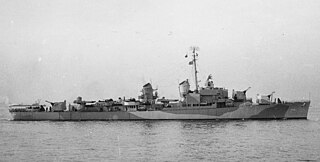
USS John R. Pierce (DD-753), an Allen M. Sumner-class destroyer, is the only ship of the United States Navy to be named for Lieutenant Commander John Reeves Pierce.
USS PC-586 was a PC-461-class submarine chaser built for the United States Navy during World War II. She was later renamed Patchogue (PC-586), the second U.S. Navy ship of the name, but never saw active service under that name.
USS PC-1119 was a PC-461-class submarine chaser built for the United States Navy during World War II. She was later renamed Greencastle (PC-1119), after Greencastle, Indiana and Greencastle, Pennsylvania, but never saw active service under that name.
USS PC-1136 was a PC-461-class submarine chaser built for the United States Navy during World War II. Shortly after the end of the war, she was renamed USS PCC-1136 when she was reclassified as a combat communications control ship. In 1956, she was renamed Galena (PC-1136), becoming the third U.S. Navy vessel so named, but never saw active service under that name.

USS Lloyd (DE-209/APD-63), a Buckley-class destroyer escort of the United States Navy, was named in honor of Ensign William R. Lloyd (1916–1942).
USS PC-1140 was a PC-461-class submarine chaser built for the United States Navy during World War II. She was later renamed Glenwood (PC-1140) but never saw active service under that name.
USS PC-565 was a PC-461-class submarine chaser built for the United States Navy during World War II. She was later renamed Gilmer (PC-565) but never saw active service under that name.
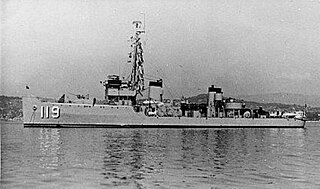
USS Sustain (AM-119) was an Auk-class minesweeper acquired by the United States Navy for the dangerous task of removing mines from minefields laid in the water to prevent ships from passing.

USS Gustafson (DE-182) was a Cannon-class destroyer escort in service with the United States Navy from 1943 to 1946. In 1950, she was transferred to the Royal Netherlands Navy where she served as Hr.Ms. Van Ewijck (F808) until 1967. She was scrapped in 1968.
USS PC-817 was a PC-461-class submarine chaser built for the United States Navy during World War II. She was later renamed Welch (PC-817) but never saw active service under that name.
USS PC-1145, later USS Winnemucca (PC-1145), was a United States Navy PC-461-class submarine chaser in commission from 1944 to 1955. In 1960, she was transferred to South Korea for service in the Republic of Korea Navy.

USS Ringness (APD-100) was a Crosley-class high speed transport that served in the United States Navy from 1944 to 1946. After spending 29 years in reserve, she was sold for scrapping in 1975.
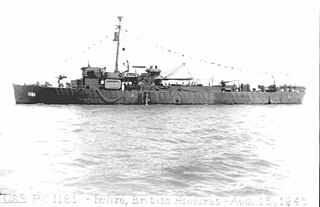
USS PC-1181 was a PC-461-class submarine chaser built for the United States Navy during World War II. She was later renamed Wildwood (PC-1181) but never saw active service under that name.












